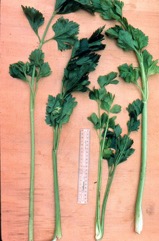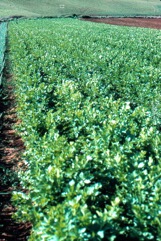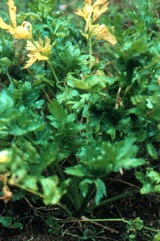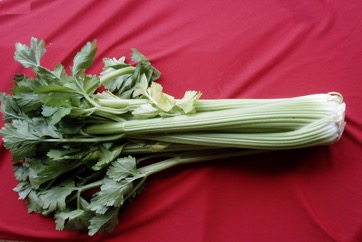Celery, Stalk celery

It is a warm temperate plant. It is mainly grown in the highlands in the tropics. It grows up to about 2100 m altitude. It is damaged by frost. It often grows naturally in swampy conditions. In the tropical lowlands it grows as a small leafy plant but can be used for flavouring. Seed germination is best at 14-21°C. It requires a rich sandy loam soil. Because celery has shallow roots it needs plenty of moisture and does best in humus rich soils. It does best with temperatures below 26°C. It needs a pH between 5.8-7.0. It suits plant hardiness zones 5-10.
Also known as:
Hon k'an, Seledri
Synonyms
- Apium dulce Mill.
Edible Portion
- Leaves, Stalks, Herb, Root, Spice, Seeds, Vegetable, Caution
Where does Celery grow?
Found in: Africa, Algeria, Asia, Australia, Cambodia, Cameroon, Caucasus, Central Africa, Chad, China, Cook Islands, Côte d'Ivoire, East Africa, East Timor, Egypt, Eritrea, Ethiopia, Fiji, Hawaii, Himalayas, India, Indochina, Indonesia, Iran, Iraq, Ivory Coast, Japan, Kenya, Kyrgyzstan, Laos, Macedonia, Malawi, Malaysia, Mediterranean, Mozambique, Nepal, New Zealand, Niger, Nigeria, North Africa, Pacific, Papua New Guinea, PNG, Philippines, Scandinavia, SE Asia, Serbia, Singapore, Slovenia, South Africa, Southern Africa, Sri Lanka, Sweden, Switzerland, Tanzania, Thailand, Timor-Leste, Tonga, Turkey, Tuvalu, United States, West Africa, Zambia, Zimbabwe
Notes: There are about 20 Apium species.
Status: It is a commercially cultivated vegetable. Plants are fairly commonly seen in highland markets in Papua New Guinea.
Growing Celery, Stalk celery
Cultivation: Plants are mostly grown from seed and transplanted. Seedlings are spaced at 10-25 cm apart. To produce white stalks, the plant is wrapped up or soil is mounded up around the plant. Newer varieties will naturally form whiter stalks. Plants should be grown close together to keep sunlight off the stalks. This applies especially for the naturally whitening (blanching) varieties. The stalks are cut before the plant flowers.
Edible Uses: The leaf stalks are eaten raw or used to flavour foods. The leaves can also be used for flavouring. The dry ripe fruit can be used for flavouring. e.g. in salt. The juice is blended with other vegetable juices. Caution: It is not recommended in large amounts during pregnancy.
Production: Leaf stalks take about 9 months from seed until harvest.
Nutrition Info
per 100g edible portion| Edible Part | Energy (kcal) | Protein (g) | Iron (mg) | Vitamin A (ug) | Vitamin c (mg) | Zinc (mg) | % Water |
|---|---|---|---|---|---|---|---|
| - | - | - | - | - | - |
Celery, Stalk celery Photos




References
Bernholt, H. et al, 2009, Plant species richness and diversity in urban and peri-urban gardens of Niamey, Niger. Agroforestry Systems 77:159-179
Bianchini, F., Corbetta, F., and Pistoia, M., 1975, Fruits of the Earth. Cassell. p 98
Blamey, M and Grey-Wilson, C., 2005, Wild flowers of the Mediterranean. A & C Black London. p 160
Burkill, H. M., 1985, The useful plants of west tropical Africa, Vol. 2. Kew.
Burnie, G & Fenton-Smith, J., 1999, A Grower's Guide to Herbs. Murdoch Books. p 20
Cheifetz, A., (ed), 1999, 500 popular vegetables, herbs, fruits and nuts for Australian Gardeners. Random House p 33
Chin, H. F., 1999, Malaysian Vegetables in Colour. Tropical Press. p 69
Cundall, P., (ed.), 2004, Gardening Australia: flora: the gardener's bible. ABC Books. p 164
Esperanca, M. J., 1988. Surviving in the wild. A glance at the wild plants and their uses. Vol. 1. p 201
Facciola, S., 1998, Cornucopia 2: a Source Book of Edible Plants. Kampong Publications, p 15
Flora of China. www.eFloras.org
Foo, J.T.S.(ed), 1996, A Guide to Common Vegetables. Singapore Science Foundation. p
French, B., 1986, Food Plants of Papua New Guinea, Asia Pacific Science Foundation p 129
French, B.R., 2010, Food Plants of Solomon Islands. A Compendium. Food Plants International Inc. p 150
Hadfield, J., 2001, The A-Z of Vegetable Gardening in South Africa. Struik p 102
http://palaeoworks.anu.edu.au/Nuno_PhD/04.pdf re Timor
Hu, Shiu-ying, 2005, Food Plants of China. The Chinese University Press. p 592
Kays, S. J., and Dias, J. C. S., 1995, Common Names of Commercially Cultivated Vegetables of the World in 15 languages. Economic Botany, Vol. 49, No. 2, pp. 115-152
Kiple, K.F. & Ornelas, K.C., (eds), 2000, The Cambridge World History of Food. CUP p 1748
Kybal, J., 1980, Herbs and Spices, A Hamlyn Colour Guide, Hamlyn Sydney p 38
Macmillan, H.F. (Revised Barlow, H.S., et al), 1991, Tropical Planting and Gardening. Sixth edition. Malayan Nature Society. Kuala Lumpur. p 362
Martin, F.W. & Ruberte, R.M., 1979, Edible Leaves of the Tropics. Antillian College Press, Mayaguez, Puerto Rico. p 121
Molla, A., Ethiopian Plant Names. http://www.ethiopic.com/aplants.htm
Mulherin, J., 1994, Spices and natural flavourings. Tiger Books, London. p 33
Niwano, Y. et al., 2009, Extensive Screening for Plant Foodstuffs in Okinawa, Japan with Anti-Obese Activity on Adipocytes, in vitro. Plant Foods in Human Nutrition 64:6-10
Ochse, J. J. et al, 1931, Vegetables of the Dutch East Indies. Asher reprint. p 699
Phon, P., 2000, Plants used in Cambodia. © Pauline Dy Phon, Phnom Penh, Cambodia. p 42
Plants for a Future database, The Field, Penpol, Lostwithiel, Cornwall, PL22 0NG, UK. http://www.scs.leeds.ac.uk/pfaf/
Purseglove, J.W., 1968, Tropical Crops Dicotyledons, Longmans. p 648
Rukmana, R., 1995, Bertanam Seledri. Penerbit Kanisius.
Seidemann J., 2005, World Spice Plants. Economic Usage, Botany, Taxonomy. Springer. p 45
Shah, S. K., 2014, Dietary contribution of underutilized minor crops and indigenous plants collected from uncultivated lands and forests in Nepal. in Promotion of Underutilized Indigenous Food Resources for Food Security and Nutrition in Asia and Pacific. FAO. Bangkok p 64
Sharma, B.B., 2005, Growing fruits and vegetables. Publications Division. Ministry of Information and broadcasting. India. p 216
Solomon, C., 2001, Encyclopedia of Asian Food. New Holland. p 71
Sukenti, K., et al, 2016, Ethnobotanical study on local cuisine of the Sasak tribe in Lombok Island, Indonesia. Journal of Ethnic Foods. 3 (2016) 189-200 p 198
Syn. pl. 1:320. 1805
Thaman, R.R., 1976, The Tongan Agricultural System, University of the South Pacific, Suva, Fiji. p 381
Thaman, R. R, 2016, The flora of Tuvalu. Atoll Research Bulletin No. 611. Smithsonian Institute p 63
Tindall, H.D., 1983, Vegetables in the Tropics, Macmillan p 399
Tyagi, R. K., et al, 2004, Conservation of Spices Germplasm in India. Indian J. Plant Genet. Resour. 17(3): 163-174
USDA, ARS, National Genetic Resources Program. Germplasm Resources Information Network - (GRIN). [Online Database] National Germplasm Resources Laboratory, Beltsville, Maryland. Available: www.ars-grin.gov/cgi-bin/npgs/html/econ.pl (10 April 2000)
van Wyk, B., 2005, Food Plants of the World. An illustrated guide. Timber press. p 64